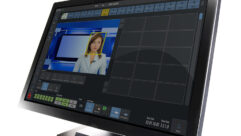The Classroom AV Control: Follow Up Q&A
Aug 27, 2010 9:31 AM
Listen to the archived webcast.
Is your university going widescreen with classroom video projection?
This is certainly on our list of things to do. All of our projectors have 16:9 aspect ratio capability, so when we have the budget to make a substantial investment in high-def media players, we plan to make the switch over a wide area of classrooms over a short time. We want to minimize the transition period so as to avoid confusion and tech trouble from that.
Are students involved with use, operation, and maitenance on the AV system?
We do not hire any students to work part time in our office so the maintenance is done by me and a full-time helper who doubles working in the print side of the operation. We do assist in classrooms when students are using computers issued to them by the university to do PowerPoint presentations in class. My role in that is to make sure the AV equipment works but as far as configuration of the computers themselves (display settings, etc.) I rely on the IT help desk people. They do not come to classrooms to assist with student computers (faculty only on the housecalls) but the students can bring their computers to the HUB (our IT helpdesk) for service, software installation and to check them for compatibility with external display devices. The HUB will install the video drivers and make the display settings necessary on the student PCs.
How do professors call for help if they run into an issue and need tech support?
They usually send someone to the office of their department and we get the call from there, or they can call us by cell phone. They can also email us directly on their laptop in the classroom. We prefer that so we have a written record of the call and we can provide an immediate visit or reply to the email. I carry a radio so that if I’m on another call I can get the word from the office and go directly to the next classroom needing help. I did experiment with putting a help button on the AV controllers, but this resulted in a lot of false alarms caused by accidental button pushes.
It is obvious to see how networked displays can make support more efficient from a small AV staff. Are you able to justify AV equipment and control investments based on this?
I have been fortunate enough to have those in charge of my department, the Office of Information Technology Services, see the benefit from networked AV systems. We are in the same department as the IT people so our leadership recognizes the benefits and workings of the AV network. At the university I graduated from, here in the state, the AV gear is still maintained by the library as it was when slide projectors were rolled around on carts and they have no networked AV systems but they do have a larger staff.
If you put the “older” equipment in rooms that don’t use that equipment often, wouldn’t that just compound the issue of the instructors not using the technology available?
The key to efficient use of the AV resources is good communication between those who schedule the classrooms and those who maintain the AV systems. Unfortunately, this frequently becomes a weak link in the administration. Instructors who need only a whiteboard get classrooms with the full blown AV podiums and some who regularly use media players end up in a classroom with a TV on a cart. After years of experience I can at least keep up with the needs of our full-time faculty and they know what each classroom has. As far as what they are willing to use, I find that the technophobes will not use the top-of-the-line gear even if they have it. At the pre-semester AV orientation, I ask the individual new adjunct faculty members what classrooms they have and clue them into what’s there so they may have time to request a room change if needed. It really pays for the newbies on the faculty to show up for the AV orientation!
Are visual communication/SIP/videoconferencing becoming AV requirements?
I just finished installing a Tandberg videoconferencing/distance learning system in one classroom that will sometimes function in that capacity over a link with our Peachtree City campus, 27 miles away. Provided that sufficient resources are devoted to training instructors in the use of the gear, such capabilities can be a real boost over spending on more brick and mortar. What can be accomplished really depends on the subject matter. For a biology lab course, you need the lab. For a theater course you need a stage and audience but for something like history, math or language courses, a videoconference link can be very effective. The technology that I see doing the most to offset the negative effects of increasing class sizes is classroom capture. This type of system allows the class lecture to be recorded on video and sound and immediately posted to a website for students to access for review. It’s not as good as having a real one-on-one Q&A with the instructor but for the money invested, it goes a long way toward improving the learning experience.










